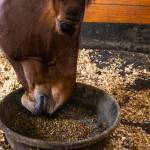Elimination Diets for Horses

Food allergies are a concern for many horse owners. According to the Merck Veterinary Manual, however, documented cases of food allergies in horses are rare. Further, clinical serum allergy tests are not recommended for food allergy diagnosis because of their unreliability.* So, what is a horse owner to do if something in a horse’s diet is suspected of causing an adverse reaction? The best practice is the elimination diet.
The first step of an elimination diet involves removing all concentrates, supplements, treats, and other additives for a minimum of four weeks, and sometimes as long as eight weeks depending on the severity of clinical signs. During this time, the horse should be maintained on a diet of only grass hay. Clinical signs need time to completely resolve before moving on to the next steps. If the horse’s signs persist on the forage-only diet, a food allergy is likely not the culprit. The horse may be sensitive to the environment or source of hay, and the next step could involve slowly swapping the forage type. However, if the horse’s signs resolve on the forage-only diet, a food allergy may be present.
The next steps involve adding things back to the diet one at a time. It is critical to only add one item per week. Let’s assume the horse remains free of clinical signs after a few weeks on the forage-only diet. Slowly add back into the diet the concentrate the horse was previously consuming over about one week. If there is no reaction, the problem is likely not a food allergy. If the problem recurs upon reintroduction of the concentrate (or other dietary item), return the horse to the forage-only diet until signs resolve. Once they resolve, it may be necessary to break down the ingredients of the concentrate to investigate which specific additive may be causing an issue.
To do this, begin adding one major component of feed at a time, such as oats, soybean meal, rice bran, or wheat middlings. Add only one component to the diet at a time, and add no more than one per week. Take note if the clinical signs return and record what those symptoms are. If signs recur, remove the item that was most recently added and allow signs to resolve. Once resolved, try adding in that item one more time. If the horse reacts, a food allergy to that item is likely present. If the symptoms do not reappear, proceed with adding back any supplements or treats one at a time, no more than one per week. Observe the horse, and repeat the procedure until a full assessment of every dietary component can be made.
A thorough investigation and elimination diet can take several weeks. “An elimination diet takes time, patience, and a good bit of work. In the long run, it is worth it to determine if the horse is likely to have a food allergy or not,” explained Katie Young, Ph.D., a nutritionist with Kentucky Equine Research. She recommends proper supplementation of EO-3, a direct source of the long-chain polyunsaturated fatty acid eicosapentaenoic acid (EPA) and docosahexaenoic acid (DHA) that may support horses with allergies or other inflammatory conditions.
The elimination diet is currently the most efficient and potentially accurate method to evaluate a food allergy or sensitivity in horses.* While the elimination diet does have some limitations—for example, clinical signs resolve but may or may not recur on subsequent challenges—it is a useful tool to help isolate a potential irritant to the horse.
*Marsella, R., S. White, V.A. Fadok, D. Wilson, R. Mueller, C. Outerbridge, and W. Rosenkrantz. 2023. Equine allergic skin diseases: Clinical consensus guidelines of the World Association of Veterinary Dermatology. Veterinary Dermatology 4:175-208.








